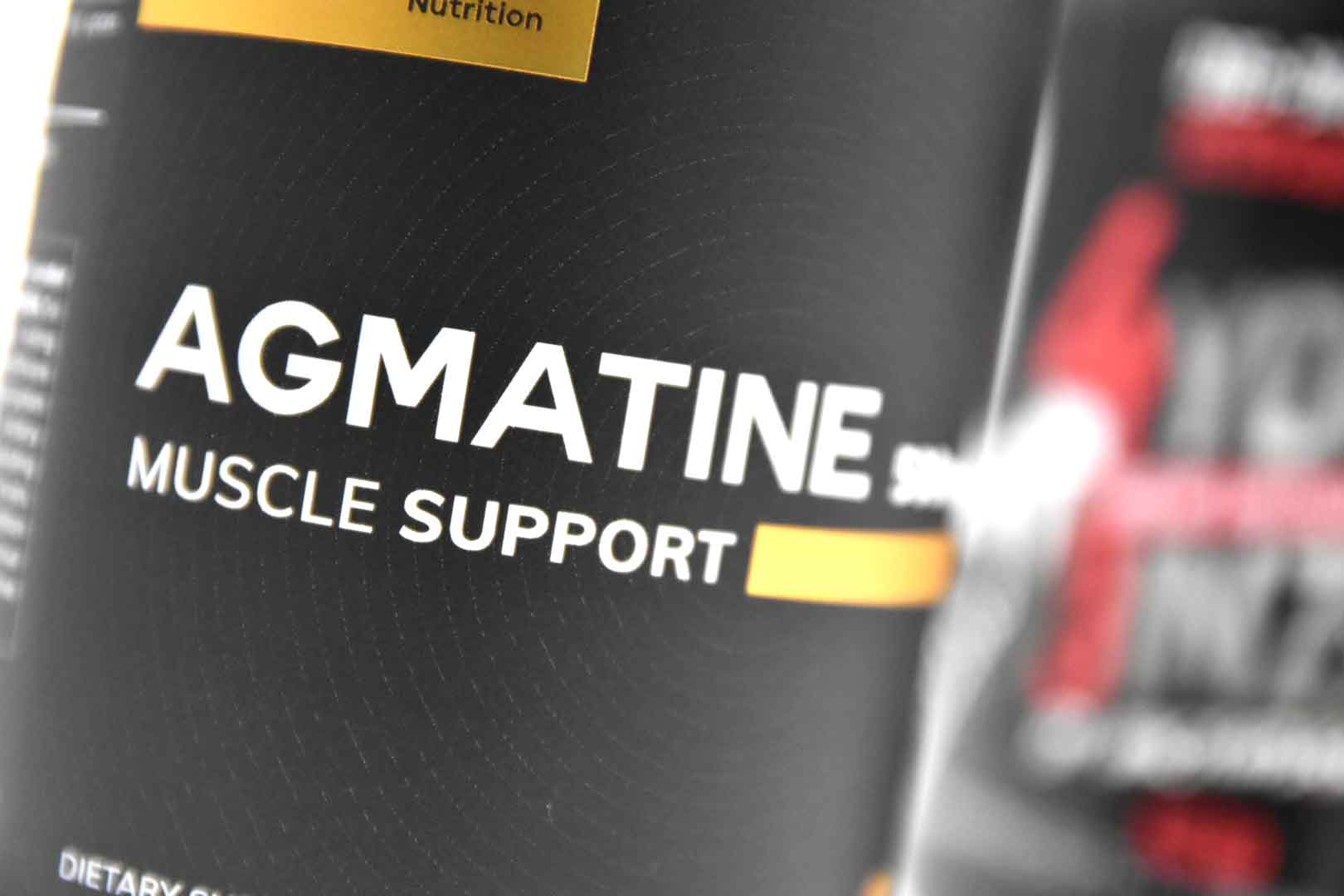
Agmatine, or agmatine (English spelling), is one of the best-known substances in the macrocosm of pre-workout supplements. It is not only well-known, but also somewhat infamous – because it influences numerous processes in the body and even has an impact on the brain. Many shops that sell agmatine therefore classify the substance as a nootropic. However, agmatine has "made a career" as a means of promoting the pump effect during weight training, especially in bodybuilding. What other effects does agmatine have? And are there any side effects to be concerned about with agmatine? Who should buy agmatine, or for whom is agmatine suitable, and how should agmatine be dosed? All this and more follows further down in the text.
Agmatine Sulfate: highly effective muscle pump with broad-spectrum action
Explanation: What is agmatine?
Agmatine (or Agmatine) is a derivative of the amino acidArginineIt is produced in the human body as a reaction to stress and/or inflammation [1], namely through decarboxylation (= the removal of a carboxyl group from arginine). Numerous foods, such as meat, fish, and certain vegetables, also contain agmatine. Unfortunately, it is difficult to measure how much agmatine the body produces daily. It is only a few milligrams. And one thing is certain: if you supply the body with agmatine in larger quantities, for example as a dietary supplement, it has astonishing effects.
Effect: How does agmatine work?
To describe the effects of agmatine, one actually has to create a list – because the effects of agmatine on the human organism are, to say the least, broad.
- Stronger blood flow, better muscle pump
First of all, agmatine triggers an increased release of nitric oxide (NO) in the body. Nitric oxide has the property of relaxing the muscles of the blood vessels, causing them to dilate considerably. This, in turn, improves blood flow to the muscles and tissue. During training, this results in a pronounced muscle pump. It's no wonder that agmatine is a component of manyPump booster(US version). Essentially, agmatine has the same effect as the amino acid arginine, from which agmatine is formed. Unlike arginine, however, the NO-releasing effect of agmatine is not caused by conversion, but rather by inhibiting nitric oxide synthase. In plain language: agmatine is not converted into NO itself; it is merely a "pusher." This is why agmatine is often combined with arginine in pump boosters – it then functions as a "super arginine." - Performance improvement
Agmatine not only provides a good pump effect, but also promotes athletic performance (although there is no scientific evidence for this yet). According to athletes' experiences with agmatine, performance improvement is particularly noticeable during short-term exercise (30–90 seconds). This is most likely due to the fact that improved blood flow to the muscles is accompanied by more effective lactate removal [2]. - Reduced sensation of pain
Agmatine appears to reduce the perception of pain. In this respect, the substance not only directly but also indirectly benefits athletic performance, as those who can tolerate pain better can naturally train harder. In a clinical study conducted on individuals with a herniated disc, participants reported significantly reduced pain perception after consuming agmatine [3]. - Facilitated fat loss
To a small extent, agmatine can facilitate the breakdown of body fat – at least that is what animal studies suggest. That agmatine promotes fat loss
Perhaps it's an exaggeration, but the substance stimulates receptors that regulate thermogenesis [4]. Thus, agmatine can mimic the effect of calorie restriction on metabolic reprogramming. - Neuromodulator function
According to recent studies, agmatine also acts as an endogenous neuromodulator and neurostimulator. This means that the substance influences the release of certain neurotransmitters in the brain that affect mood. In animal studies, agmatine administration has shown antineurotoxic and antidepressant-like effects [1]. Behavioral changes occurred that suggest an anxiolytic and mood-enhancing effect. Based on these findings, it is being discussed whether agmatine could play a role in the brain in the treatment of depression, anxiety, neuropathic pain, and cognitive decline. In summary, agmatine is an excellent pre-workout supplement. It works on both physical and psychological levels, and it is not even a foreign substance.
History of Agmatine: When was Agmatine discovered?
Agmatine has been known since 1910 – the German physiologist Albrecht Kossel identified agmatine in Heringen [5] – but the substance's physiological significance remained hidden from medicine for almost a century. For a long time, it was thought to occur only in lower life forms. It wasn't until 1994 that the biosynthetic pathway (decarboxylation of arginine) through which agmatine is also formed in the brain of mammals and humans was discovered [1]. When it was later discovered that agmatine has a strong blood circulation-stimulating effect, the substance quickly established itself as an effective ingredient in potency enhancers and sports supplements, especially pump boosters.
Variants: What forms of agmatine are there?
Instead of pure agmatine, supplement manufacturers prefer to use agmatine sulfate. This is the sulfated form of agmatine—a form combined with sulfuric acid salt. Why is agmatine sulfate more attractive to the industry than pure agmatine? Because the latter is relatively unstable and therefore does not have the best bioavailability. By combining it with sulfuric acid salt, agmatine becomes more stable and can therefore be better absorbed by the body.
Agmatine dosage: How should you dose agmatine?
The dosage recommendations of the manufacturers of agmatine preparations range from 500 mg to 2,500 mg daily. The dosage form (powder or capsules) is irrelevant. However, if agmatine is taken as a standalone preparation, 500 mg is not much. Athletes' experiences with agmatine show that a good effect (pronounced muscle pump, reduced "muscle burn" during training sets) is achieved starting at 1,000 mg. Dosages above 2,000 mg are not recommended, as above this amount there is no longer any improvement in effect compared to lower doses.
Anyone wanting to "boost" with agmatine should take the substance about 20–30 minutes before a workout. This is how long it takes for it to be fully absorbed and take effect in the body. It's impossible to say exactly how long the effect will last—it varies from athlete to athlete. With agmatine-containing pump boosters orPre-workout boostersThe duration of the effect also depends on the other components of the respective booster product. However, you can definitely complete a one- to one-and-a-half-hour workout within the effective time.
Agmatine Side Effects: What are the side effects of agmatine?
Regarding agmatine side effects, the all-clear can be given: Agmatine does not appear to have any significant side effects. At doses above 3.5 g daily, some subjects in human studies experienced diarrhea and mild nausea – that was it [3]. A long-term study in which subjects took approximately 2.7 grams of agmatine sulfate in gelatin capsules daily for five years concluded that agmatine supplementation at this dosage did not negatively affect health [6].
Buy Agmatine: Where can you order Agmatine?
Regarding the purchase of agmatine, there is the problem that the substance falls under the so-called“Novel Food Regulation” (EU 2015/2283)This means that, while marketing is not prohibited in principle, it is only permitted after undergoing an approval procedure. Since no manufacturer has yet applied for such a procedure – because it is very costly – agmatine is theoretically not allowed to be sold in the EU. In practice, however, numerous agmatine preparations and supplements containing agmatine are available online. Outside the EU, for example in the USA, agmatine is a completely legal supplement. However, you can't find agmatine on every corner – and certainly not in German drugstores or supermarkets.
If you want to use agmatine not as a single substance, but as a synergistic mixture of substances in the form of a booster drink, you should of course pay attention to the label when purchasing the booster – and make sure you buy the correct product version. Many agmatine-containing boosters from renowned US brands, such as the Pump Booster,Levrone Shaaboom Pumpfrom the Kevin Levrone Signature Series are sold in two different versions: a US version (= with agmatine) and an EU version (= without agmatine). The EU version is not necessarily inferior to the US version, but it does not contain agmatine.
- A. Halaris, J. Plietz (2007): “Agmatine: metabolic pathway and spectrum of activity in brain” – CNS Drugs (https://pubmed.ncbi.nlm.nih.gov/17927294/)
- supplement-bewertung.de (2023): Agmatine: Effects, Experiences, Intake, Studies (https://supplement-bewertung.de/agmatin/)
- O. Keynan et al. (2010): "Safety and Efficacy of Dietary Agmatine Sulfate in Lumbar Disc-associated Radiculopathy. An Open-label, Dose-escalating Study
Followed by a Randomized, Double-blind, Placebo-controlled Trial” – Pain Med (https://pubmed.ncbi.nlm.nih.gov/20447305/) - I. Nissim (2014): “The Molecular and Metabolic Influence of Long Term Agmatine Consumption” – J Biol Chem.
(https://www.ncbi.nlm.nih.gov/pmc/articles/PMC3975019/) - wikipedia.org: Agmatine – History (https://de.wikipedia.org/wiki/Agmatin#Geschichtliches)
- GM Gilad, VH Gilad (2014): “Long-term (5 years), high daily dosage of dietary agmatine--evidence of safety: a case report” – J Med Food
(https://pubmed.ncbi.nlm.nih.gov/25247837/)







